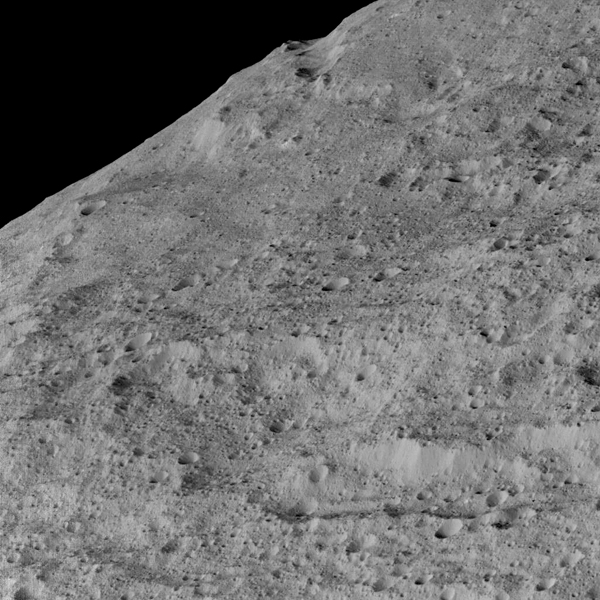Dwarf Planet Ceres' Stretched-Out Surface Revealed in New Photos

NASA's Dawn probe took a series of stunning new images of Ceres' chain of craters called Gerber Catana, from an altitude of just 240 miles (385 kilometers) – the closest the spacecraft has ever come to the dwarf planet.
Among the major science findings from the close-up view is the discovery that Ceres, despite its diminutive size (only about 590 miles wide, or 950 km), displays internal stresses similar to what you would find on a larger body, such as Mars. Grooves and troughs on the surface of Ceres were mostly created after meteorite impacts, but some are shaped in a way that suggests tectonic forces.
"Why [the groves and troughs] are so prominent is not yet understood, but they are probably related to the complex crustal structure of Ceres," said Paul Schenk, a Dawn science team member at the Lunar and Planetary Institute in Houston, in a statement.
Dawn's backup framing camera snapped the images to test out its capabilities. The primary camera is also working perfectly and began taking pictures at this altitude Dec. 16.
Meanwhile, Dawn is looking for signatures of minerals and various elements on Ceres using an onboard instrument called the visible and infrared mapping spectrometer (which detects light reflected off the surface) in concert with the gamma-ray and neutron detector (which looks for components of nuclear radiation), the statement said.
Breaking space news, the latest updates on rocket launches, skywatching events and more!
The $466 million probe left Earth in 2007, made a stop at another large body in the asteroid belt, Vesta, and arrived at Ceres last March.
A few weeks ago, the Dawn spacecraft may have finally solved a particularly perplexing mystery of Ceres: Observations by the probe showed that mysterious bright spots on the dwarf planet's surface are likely salt deposits.
"As we take the highest-resolution data ever from Ceres, we will continue to examine our hypotheses and uncover even more surprises about this mysterious world," said Chris Russell, principal investigator of the Dawn mission who is based at the University of California, Los Angeles.
Follow Elizabeth Howell @howellspace. Follow us @Spacedotcom, Facebook and Google+. Original article on Space.com.

Elizabeth Howell (she/her), Ph.D., was a staff writer in the spaceflight channel between 2022 and 2024 specializing in Canadian space news. She was contributing writer for Space.com for 10 years from 2012 to 2024. Elizabeth's reporting includes multiple exclusives with the White House, leading world coverage about a lost-and-found space tomato on the International Space Station, witnessing five human spaceflight launches on two continents, flying parabolic, working inside a spacesuit, and participating in a simulated Mars mission. Her latest book, "Why Am I Taller?" (ECW Press, 2022) is co-written with astronaut Dave Williams.


